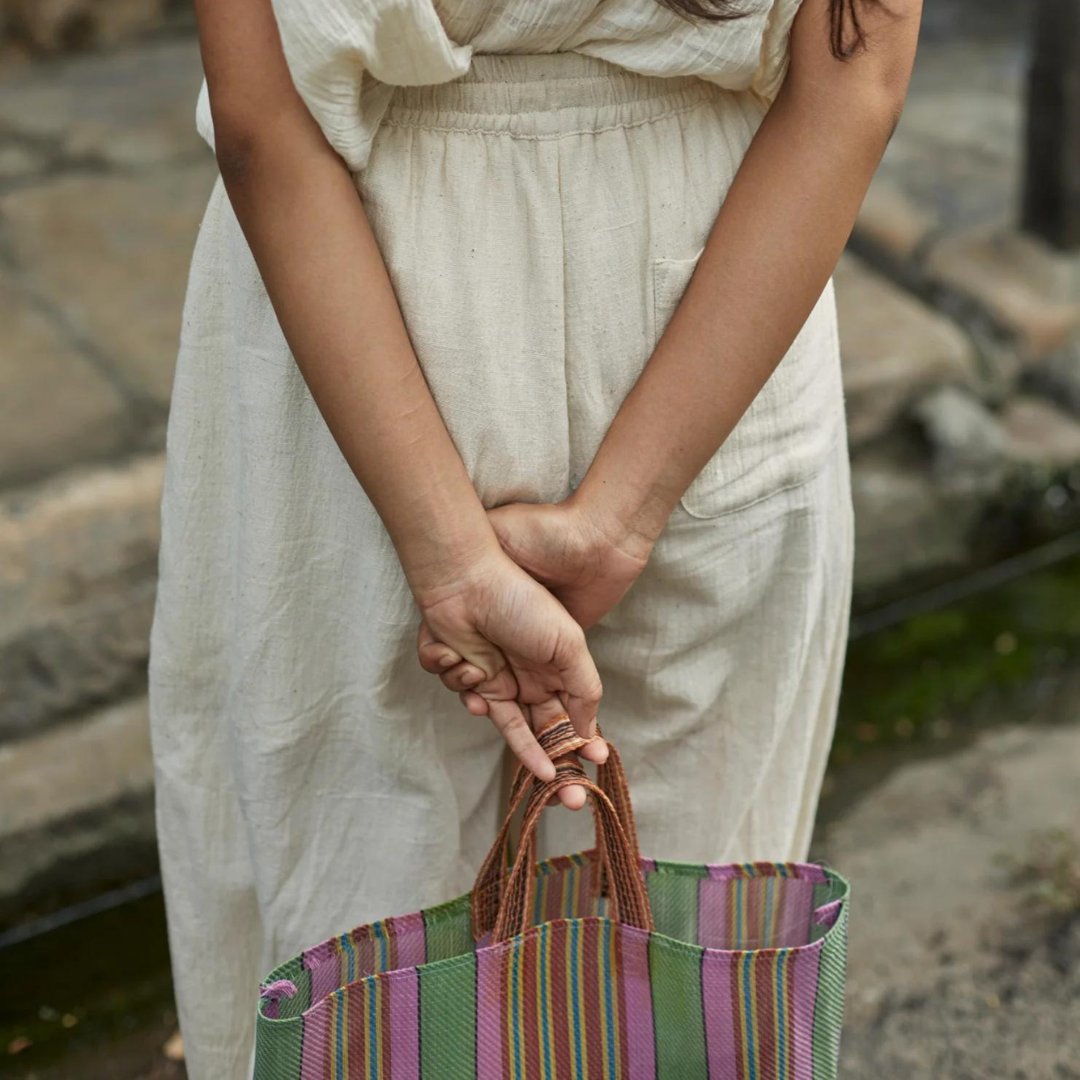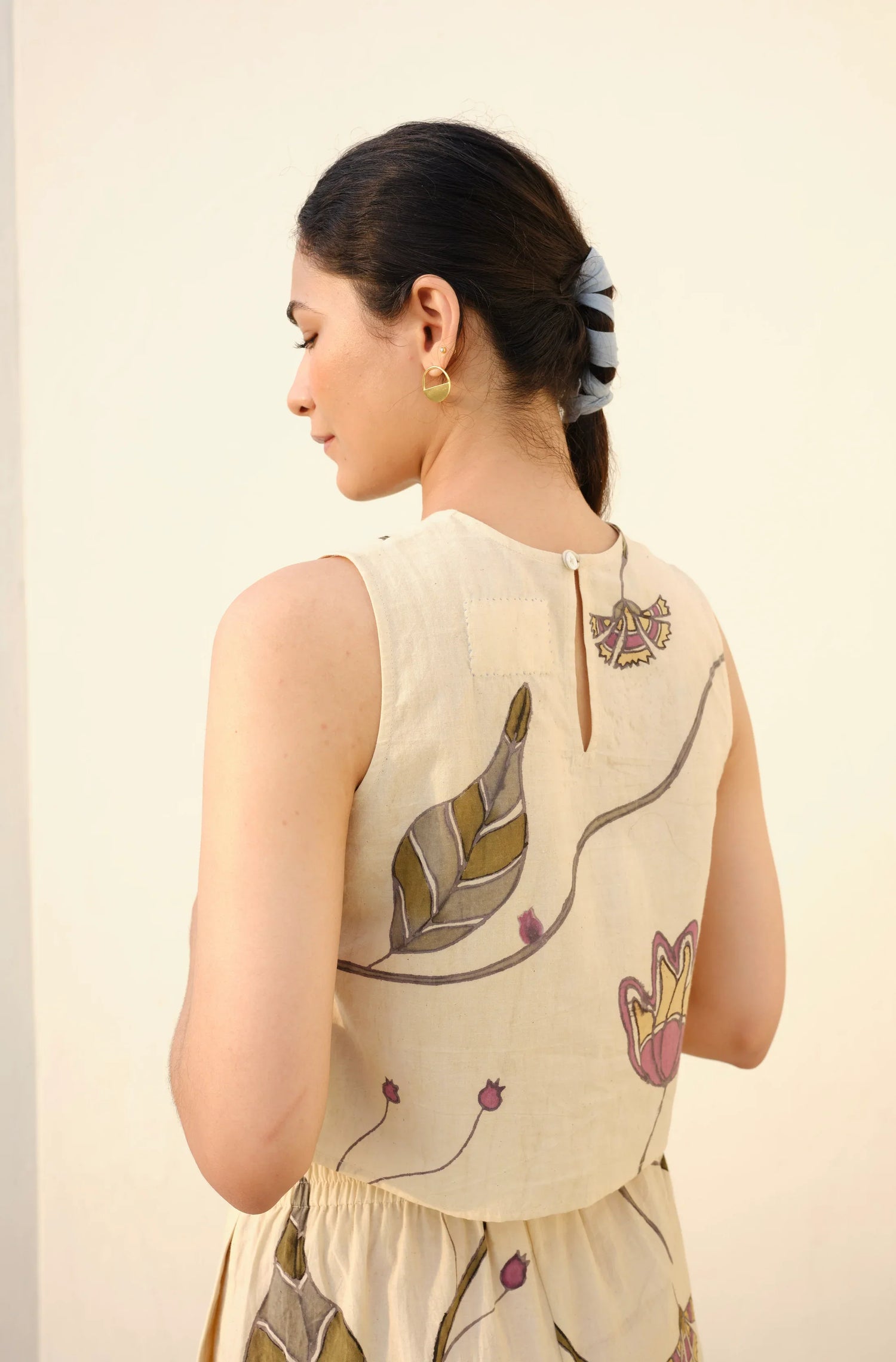Clotho Codex
Welcome to The Clotho Codex, where we uncover the unique stories of textile-making from South Asia. Our guide takes you through the diverse and intricate fabric-making techniques that have been part of the region's history, culture, and art.
Location: Varanasi, Uttar Pradesh.
Timeline: The craft flourished during the Mughal period, especially under Emperor Akbar in the 16th century.
Now: Banarasi silk remains a staple in Indian weddings and festivities, with ongoing efforts to preserve traditional methods while innovating with modern designs.
Origin: Ikat is a resist dyeing technique prevalent in many cultures, with a significant history in India. The technique involves dyeing the threads before weaving them into fabric, creating intricate patterns and designs.
Location: Prominent in Andhra Pradesh, Odisha, and Gujarat.
Timeline: The art of Ikat weaving in India can be traced back to the 6th century, with evidence of its presence in various historical periods.
Now: Indian Ikat is celebrated for its vibrant patterns and is used across traditional and contemporary fashion and home decor.
Origin: Khadi is a hand-spun and hand-woven cloth that became emblematic of Indian self-reliance and independence, promoted by Mahatma Gandhi during the Swadeshi Movement to boycott foreign goods.
Location: Produced across India, with significant production in rural areas.
Timeline: Popularized by Gandhi in the 1920s, khadi has ancient roots, serving as a versatile fabric throughout India's history.
Now: Khadi has seen a resurgence as a symbol of sustainable and eco-friendly fashion, supported by the Government of India.
Location: Kashmir Valley
Timeline: The craft of Pashmina weaving has a rich legacy dating back to the 15th century in Kashmir, woven into the socio-cultural fabric of the region.
Now: Pashmina shawls and scarves remain luxury items, with artisans striving to maintain the traditional quality and authenticity.
Location: Patan, Gujarat.
Timeline: The tradition of Patola weaving has been present in Gujarat since the 11th century, historically reserved for royalty and the aristocracy.
Now: Due to the complex process, authentic Patola sarees are rare and highly valued, with a few families in Patan still preserving the tradition.
Location: Kanchipuram, Tamil Nadu.
Timeline: The craft is traced back to the Pallava Dynasty (6th to 9th century), flourishing under the patronage of the Chola and Vijayanagara Empires.
Now: Kanjeevaram sarees are essential in South Indian weddings and religious ceremonies, renowned for their grandeur and intricate designs.
Location: Kanchipuram, Tamil Nadu.
Timeline: The craft is believed to have been practiced since the Pallava Dynasty (6th to 9th century).
Now: Kanjeevaram sarees are considered a must-have in South Indian weddings and festivities, renowned for their vibrant colors and intricate designs.
Location: Originally Dhaka, now West Bengal and Bangladesh.
Timeline: The art of Jamdani weaving is believed to date back to the 14th century, reaching its zenith in the Mughal era.
Now: Despite challenges, the Dhakai Jamdani continues to be produced, valued for its artistic and labor-intensive process. It has been recognized by UNESCO as an Intangible Cultural Heritage of Humanity.
Location: Chanderi, Madhya Pradesh.
Timeline: The tradition dates back to the 7th century, with historical mentions in Maasir-i-Alamgiri and Ain-i-Akbari, indicating its royal patronage.
Now: Chanderi fabrics have gained popularity for their ethereal quality and are a staple in Indian wardrobes for their blend of sophistication and comfort.
Timeline: The use of Muga silk dates back to the Ahom dynasty in the 13th century, revered in Assamese culture for its durability and natural luster.
Location: Assam.
Now: Muga silk remains integral to Assamese tradition, used in making mekhela chadors and sarees. Its production is safeguarded as a geographical indication.
Timeline: The cultivation and weaving of Tussar silk have been practiced in India for centuries, with evidence dating back to the medieval period.
Location: Predominantly in Jharkhand, Bihar, Odisha, and West Bengal.
Now: Tussar continues to be a popular fabric for sarees and ethnic wear, appreciated for its organic look and feel.
Timeline: The legacy of the Chendamangalam weave dates back to the ancient times of the Cochin Kingdom. Its roots can be traced to the centuries-old weaving communities in Kerala, where it has been passed down through generations.
Location: The Chendamangalam weave is specific to its namesake village in Kerala, which has been recognized as a geographical indication by the Government of India, signifying its unique cultural and historical importance.
Now: Today, the Chendamangalam weave continues to be esteemed for its elegance and is primarily used to create the traditional Kerala 'Mundu', 'Neriyathu', and other ethnic garments. It remains a symbol of cultural identity and heritage, promoting sustainable fashion through its eco-friendly processes.
Timeline: The tradition of the Kasavu weave is an evolution of the ancient Mundum Neriyathum, the oldest form of saree draping in Kerala. It has a rich history that goes back over 500 years, influenced by ancient Hindu as well as Greco-Roman culture.
Location: The Kasavu weaves are predominantly produced in the Balaramapuram region of Thiruvananthapuram, Kerala, which is the heart of Kasavu production.
Now: In the present day, Kasavu sarees are synonymous with Kerala's cultural identity, especially during festivals and celebrations like Onam. The craft has gained popularity across the country and is a sought-after fabric for its timeless appeal and elegance. It represents the artisanal craftsmanship of Kerala's weavers and their commitment to preserving the tradition.
Weaves
1.Banarasi Silk Weaving
Origin: Rooted in the ancient city of Varanasi, Banarasi silk weaving is a blend of Indian weaving techniques and Persian motifs, brought by the Mughals. The technique is known for its intricate designs, heavy gold work, compact weaving, figures with small details, metallic visual effects, and the inclusion of motifs like kalga and bel.Location: Varanasi, Uttar Pradesh.
Timeline: The craft flourished during the Mughal period, especially under Emperor Akbar in the 16th century.
Now: Banarasi silk remains a staple in Indian weddings and festivities, with ongoing efforts to preserve traditional methods while innovating with modern designs.
2. Ikat Weaving
Origin: Ikat is a resist dyeing technique prevalent in many cultures, with a significant history in India. The technique involves dyeing the threads before weaving them into fabric, creating intricate patterns and designs.Location: Prominent in Andhra Pradesh, Odisha, and Gujarat.
Timeline: The art of Ikat weaving in India can be traced back to the 6th century, with evidence of its presence in various historical periods.
Now: Indian Ikat is celebrated for its vibrant patterns and is used across traditional and contemporary fashion and home decor.
3. Khadi
Origin: Khadi is a hand-spun and hand-woven cloth that became emblematic of Indian self-reliance and independence, promoted by Mahatma Gandhi during the Swadeshi Movement to boycott foreign goods.Location: Produced across India, with significant production in rural areas.
Timeline: Popularized by Gandhi in the 1920s, khadi has ancient roots, serving as a versatile fabric throughout India's history.
Now: Khadi has seen a resurgence as a symbol of sustainable and eco-friendly fashion, supported by the Government of India.
4. Pashmina Weaving
Origin: Pashmina, known for its softness and warmth, is made from the fine undercoat of the Changthangi goat, native to the high-altitude regions of Kashmir. The word 'pashmina' comes from 'Pashm', meaning wool in Persian.Location: Kashmir Valley
Timeline: The craft of Pashmina weaving has a rich legacy dating back to the 15th century in Kashmir, woven into the socio-cultural fabric of the region.
Now: Pashmina shawls and scarves remain luxury items, with artisans striving to maintain the traditional quality and authenticity.
5. Patola Weaving
Origin: Patola weaving, known for its double ikat technique, is a labor-intensive process that produces intricately patterned silk sarees. The art is believed to have been brought to Patan by the Solanki Rajputs, who were patrons of this craft.Location: Patan, Gujarat.
Timeline: The tradition of Patola weaving has been present in Gujarat since the 11th century, historically reserved for royalty and the aristocracy.
Now: Due to the complex process, authentic Patola sarees are rare and highly valued, with a few families in Patan still preserving the tradition.
6. Kanjeevaram Silk Weaving
Origin: Originating from the town of Kanchipuram in Tamil Nadu, Kanjeevaram silk weaving is famed for its vibrant colors and durability. The weavers are believed to be descendants of Sage Markanda, the master weaver of the gods.Location: Kanchipuram, Tamil Nadu.
Timeline: The craft is traced back to the Pallava Dynasty (6th to 9th century), flourishing under the patronage of the Chola and Vijayanagara Empires.
Now: Kanjeevaram sarees are essential in South Indian weddings and religious ceremonies, renowned for their grandeur and intricate designs.
7. Kanjeevaram Silk Weaving
Origin: Originating from the town of Kanchipuram in Tamil Nadu, this weaving technique is famed for its durability and the opulence of its motifs, often inspired by temple architecture.Location: Kanchipuram, Tamil Nadu.
Timeline: The craft is believed to have been practiced since the Pallava Dynasty (6th to 9th century).
Now: Kanjeevaram sarees are considered a must-have in South Indian weddings and festivities, renowned for their vibrant colors and intricate designs.
8. Dhakai Jamdani
Origin: The Dhakai Jamdani is a fine muslin textile from Bengal, characterized by intricate motifs woven on the loom. It is a heritage craft that blends the ancient muslin weaving techniques of Bengal with the Jamdani pattern style, which originated in Dhaka, Bangladesh.Location: Originally Dhaka, now West Bengal and Bangladesh.
Timeline: The art of Jamdani weaving is believed to date back to the 14th century, reaching its zenith in the Mughal era.
Now: Despite challenges, the Dhakai Jamdani continues to be produced, valued for its artistic and labor-intensive process. It has been recognized by UNESCO as an Intangible Cultural Heritage of Humanity.
9. Chanderi Weaving
Origin: Chanderi weaving originates from the Vindhya region of Madhya Pradesh and is known for its lightweight, translucent texture, combining silk and cotton with zari motifs.Location: Chanderi, Madhya Pradesh.
Timeline: The tradition dates back to the 7th century, with historical mentions in Maasir-i-Alamgiri and Ain-i-Akbari, indicating its royal patronage.
Now: Chanderi fabrics have gained popularity for their ethereal quality and are a staple in Indian wardrobes for their blend of sophistication and comfort.
10. Muga Silk
Origin: Exclusive to Assam, Muga silk is renowned for its natural golden sheen, derived from the semi-domesticated silkworm Antheraea assamensis endemic to the region.Timeline: The use of Muga silk dates back to the Ahom dynasty in the 13th century, revered in Assamese culture for its durability and natural luster.
Location: Assam.
Now: Muga silk remains integral to Assamese tradition, used in making mekhela chadors and sarees. Its production is safeguarded as a geographical indication.
11. Tussar Silk
Origin: Tussar silk, also known as 'wild silk', is made from the cocoons of silkworms found in the forests of Jharkhand, Bihar, Odisha, and West Bengal. It is valued for its rich texture and natural deep gold color.Timeline: The cultivation and weaving of Tussar silk have been practiced in India for centuries, with evidence dating back to the medieval period.
Location: Predominantly in Jharkhand, Bihar, Odisha, and West Bengal.
Now: Tussar continues to be a popular fabric for sarees and ethnic wear, appreciated for its organic look and feel.
12. Chendamangalam Weave
Origin: Chendamangalam weave is a traditional and exquisite handloom style that originates from the village of Chendamangalam in the Ernakulam district of Kerala, India. This handloom weaving tradition is known for its fine texture, simplicity, and exceptional quality.Timeline: The legacy of the Chendamangalam weave dates back to the ancient times of the Cochin Kingdom. Its roots can be traced to the centuries-old weaving communities in Kerala, where it has been passed down through generations.
Location: The Chendamangalam weave is specific to its namesake village in Kerala, which has been recognized as a geographical indication by the Government of India, signifying its unique cultural and historical importance.
Now: Today, the Chendamangalam weave continues to be esteemed for its elegance and is primarily used to create the traditional Kerala 'Mundu', 'Neriyathu', and other ethnic garments. It remains a symbol of cultural identity and heritage, promoting sustainable fashion through its eco-friendly processes.
13. Kasavu Weave
Origin: The Kasavu weave is a hallmark of Kerala's textile industry, known for the distinctive gold and copper zari used on the border, giving it a regal and traditional appearance. It is renowned for its minimalistic design and the use of fine cotton.Timeline: The tradition of the Kasavu weave is an evolution of the ancient Mundum Neriyathum, the oldest form of saree draping in Kerala. It has a rich history that goes back over 500 years, influenced by ancient Hindu as well as Greco-Roman culture.
Location: The Kasavu weaves are predominantly produced in the Balaramapuram region of Thiruvananthapuram, Kerala, which is the heart of Kasavu production.
Now: In the present day, Kasavu sarees are synonymous with Kerala's cultural identity, especially during festivals and celebrations like Onam. The craft has gained popularity across the country and is a sought-after fabric for its timeless appeal and elegance. It represents the artisanal craftsmanship of Kerala's weavers and their commitment to preserving the tradition.
Collections
-

Clotho Collective
Clotho Collective offers a unique made-to-order retail experience where you, the customer,...



